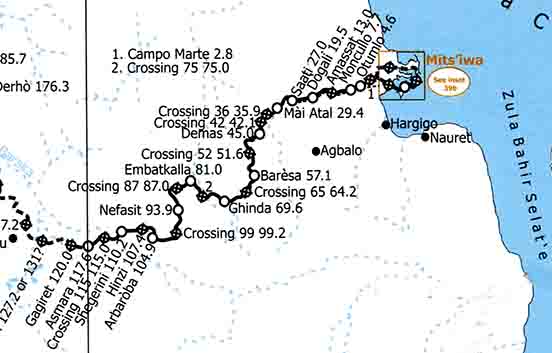Construction of the state railways of Eritrea commenced in 1887 by the Italians, being built throughout to the standard Italian narrow gauge of 950 millimeters. The intention for the railway was to link with the railways of both Sudan and Ethiopia, having an operational length from Massawa to Biscia as originally constructed, of over 300 Km. The final picture in the gallery was taken on the Biscia line, closed to all traffic in 1972.
The line ran from sea level at Massawa up to a height of 7,143 feet to arrive at the capital of Eritrea, Asmara, reaching there in 1911. From there the line continued towards the Sudanese border, reaching the town of Biscia, in 1925. The line passed through a great deal of extremely challenging terrain, necessitating the building of numerous bridges, viaducts, tunnels and embankments, as well as steep gradients and tight curves. The lengthy construction period for the full line can be attributed to the terrain, and to changes in the political circumstances during this period.
Commencing a journey from the port of Massawa, the line passes through a coastal desert where vegetation is sparse and mostly thorn bushes. A dry river bed for the river Obel is crossed near the town of Dogali by an impressive thirteen-arch brick bridge. As a significant structure, the bridge has been celebrated nationally appearing on an Eritrean 10 Nakfa banknote as illustrated below.

Similarly the railway appeared on a postage stamp dating from the 1930's during the Italian colonisation.

After Dogali the settlement of Mai Atal is reached, by which time the railway has already climbed to 551 feet. The railway then passes along a broad valley as it climbs remotely to Damas where the first of thirty tunnels on the line is encountered. By the time the train reaches the station at Ghinda the altitude has risen to an impressive 3,258 feet. At this point the surrounding vegetation has changed from dreary thorn bushes to a lively selection of temperate green bushes.
After Ghinda some serious hard work is required by the locomotive to traverse the relentless 1 in 28 gradient and the 230 foot radius curves on the journey ahead. The railway travels through much spectacular scenery, clinging to the contours of the land and passing through a further series of tunnels before reaching the station at Nefasit. The line continues to twist and turn making a sinuous line on the side of the mountain as yet more altitude is gained. Most impressively, it is possible to view the various levels of the railway track, both above and below from the train, as you gaze back across the mountainside.
Departure from Arboroba station takes the line on a high embankment above the settlement where the line runs parallel with the road for the next few kilometers. At Shegerini station it is possible to see the line curling away to the summit above giving a sense of the drama still yet to come. Eventually the spectacular four arched bridge is crossed and then after several tunnels and loops the line emerges onto a high ledge which has been christened "Devil's Gate". This part of the line is not for the faint-hearted with a rock face on one side of the train and a sheer drop of several thousand feet on the other. The summit of the line at 7,303 feet is eventually reached, after which the line falls back down into Asmara station some 160 feet lower.
The line onwards from Asmara to Biscia closed to traffic in 1974, with the line to Massawa closing a year later in 1975 after a period of much political unrest during the previous years. Thankfully, after Eritrea gained independence in 1991, the rebuilding of the railway from Massawa to Asmara was undertaken as a priority by the Eritrean government, culminating in the re-opening to Asmara in February 2003. It is now once again possible to travel over this spectacular line that really must rank firmly in the top ten of the world's most scenic railway journeys.
To operate the trains over the line the railway had a mixed fleet of steam motive power, the most notable being the Class 440, 441 and 442 0-4+4-0T Mallets built by Ansaldo, and Class 202 0-4-0T built by Breda. Additionally the railway possessed several Fiat railcars plus a number of Drewry and Krupp built small diesel locomotives.
In the attached table is an extract of the builders details for a selection of steam locomotive classes, at one time in use on the railways of Eritrea. The details are as per the original builders lists and ignore any swapping of plates that may have taken place over the years.
The pictures in this gallery start at Abrascio 47km north west of Asmara, continue on through the city and on eastwards down to the coast at Massawa.
To view any full size image and caption details please click the maroon button below each thumbnail


